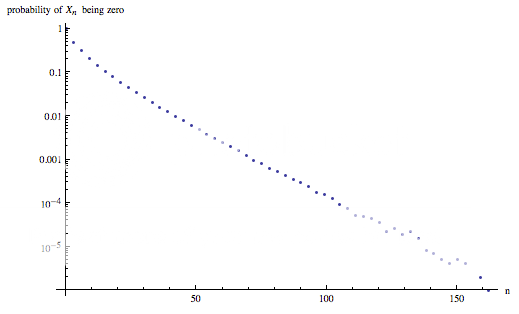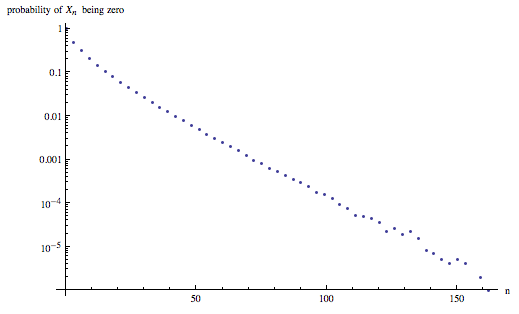The results from considering $10^6$ pseudorandom $X_n$ for $n\leq 200$ suggest that the probability of being zero might decay exponentially:
 $X_n$ being zero versus $n$" />
$X_n$ being zero versus $n$" /> $X_n$ being zero versus $n$" />
$X_n$ being zero versus $n$" />
The best expoenentialexponential fit is something like $e^{-1.18-0.0764n}$. The base of the exponential growth is $e^{-.0764}\approx0.926$ which is consistent with the upper bound from Gjergji Zaimi's answer of $(27/32)^{1/3}\approx0.945$.
The probability density function for the number of zeroes in each sequence also seems to decay exponentially (the y-axis ought to read "Probabilty"Probability of having $z$ zeroes in $\{X_i\}_{i=0}^{200}$", and this plot really should start at $z=1$, rather than $z=0$):
 $z$ zeroes in $\{X_i\}_{i=0}^{200}$" versus $z$" />
$z$ zeroes in $\{X_i\}_{i=0}^{200}$" versus $z$" /> $z$ zeroes in $\{X_i\}_{i=0}^{200}$" versus $z$" />
$z$ zeroes in $\{X_i\}_{i=0}^{200}$" versus $z$" />
The best exponential fit is something like $0.618e^{-0.481z}$.
These were produced with the following Mathematica code (with apologies to Mathworld's page):
max = 200;
max2 = 10^6;
stats = Table[m = #[[1, 1]] & /@ FoldList[Dot, IdentityMatrix[2], {{0, 1}, {1, #}} & /@ ((-1)^Table[Random[Integer], {max}])];
Flatten[Position[m, 0], 1], {max2}];
numstats = Tally[Table[Length[stats[[i]]], {i, max2}]];
numstats2 = Table[{numstats[[i, 1]], numstats[[i, 2]]/max2}, {i, Length[numstats]}];
ListLogPlot[numstats2, AxesLabel -> {"z", "probability of z zeros in \!\(\*SubscriptBox[\(X\), \(0\)]\) to \\!\(\*SubscriptBox[\(X\), \(200\)]\)"}]
fstats = Tally[Flatten[stats, 1]];
fstats2 = Table[{fstats[[i, 1]] - 2, fstats[[i, 2]]/max2}, {i, Length[fstats]}];
ListLogPlot[fstats2, AxesLabel -> {"n", "probability of \!\(\*SubscriptBox[\(X\), \(n\)]\) being zero"}]


